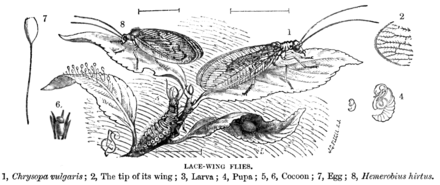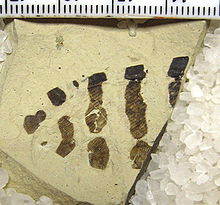Neuroptera
| Neuroptera | |
|---|---|

| |
| Green lacewing | |
| Scientific classification | |
| Kingdom: | Animalia |
| Phylum: | Arthropoda |
| Class: | Insecta |
| (unranked): | Neuropterida |
| Order: | Neuroptera Linnaeus, 1758 |
| Suborders | |
|
and see text | |
The insect order Neuroptera, or net-winged insects, includes the lacewings, mantidflies, antlions, and their relatives. The order consists of some 6,000 species.[1] Neuroptera can be grouped together with the Megaloptera and Raphidioptera in the unranked taxon Neuropterida (once known as Planipennia) including: alderflies, fishflies, dobsonflies, and snakeflies.
Adult Neuropterans have four membranous wings, all about the same size, with many veins. They have chewing mouthparts, and undergo complete metamorphosis.
Neuropterans first appeared during the Permian period, and continued to diversify through the Mesozoic era.[2] During this time, several unusually large forms evolved, especially in the extinct family Kalligrammatidae, often called "the butterflies of the Jurassic" for their large, patterned wings.[3]
Anatomy and biology[]
Neuropterans are soft-bodied insects with relatively few specialized features. They have large lateral compound eyes, and may or may not also have ocelli. Their mouthparts have strong mandibles suitable for chewing, and lack the various adaptations found in most other endopterygote insect groups.
They have four wings, usually similar in size and shape, and a generalised pattern of veins.[4] Some neuropterans have specialised sense organs in their wings, or have bristles or other structures to link their wings together during flight.[5]
The larvae are specialised predators, with elongated mandibles adapted for piercing and sucking. The larval body form varies between different families, depending on the nature of their prey. In general, however, they have three pairs of thoracic legs, each ending in two claws. The abdomen often has adhesive discs on the last two segments.[5]
Life cycle and ecology[]

The larvae of most families are predators. Many chrysopids, hemerobids and coniopterygids eat aphids and other pest insects, and some have been used for biological control (either from commercial distributors, but also abundant and widespread in nature).[6][7]
 Larva of , Osmylidae |
Larvae in various families cover themselves in debris (sometimes including dead prey insects) as camouflage, taken to an extreme in the ant lions, which bury themselves completely out of sight and ambush prey from "pits" in the soil. Larvae of some Ithonidae are root feeders, and larvae of Sisyridae are aquatic, and feed on freshwater sponges. A few mantispids are parasites of spider egg sacs.
As in other holometabolic orders, the pupal stage is enclosed in some form of cocoon composed of silk and soil or other debris. The pupa eventually cuts its way out of the cocoon with its mandibles, and may even move about for a short while before undergoing the moult to the adult form.[5]
Adults of many groups are also predatory, but some do not feed, or consume only nectar.
Beetles, wasps, and some lake flies parasitize neuropteran larvae.
Evolution[]

Fossil history[]
Neuropterans first appeared near the end of the Permian period, as shown by fossils of the from the Tunguska basin in Siberia and a similar fauna from Australia.[2]
The osmylids are of Jurassic or Early Cretaceous origin and may be the most ancient of the Neuropteran groups.[8] The extinct osmylid is fossilized in middle Eocene Baltic amber.[9] The genus Burmaleon is described from two fossils of Cenomanian age Burmese amber, implying crown group radiation in the Early Cretaceous or earlier.[10][11] The family Kalligrammatidae lived from the Jurassic to Aptian (Lower Cretaceous) periods.[12]
Ithonidae are from the Jurassic to Recent, and the extinct lineages of the family were widespread geographically.[13]
Phylogeny[]
Molecular analysis in 2018 using mitochondrial rRNA and mitogenomic data places the Neuroptera within the Neuropterida, sister to the Raphidioptera and containing the Megaloptera (sister to the rest of the Neuroptera).[14][8] The fossil record has contributed to the understanding of the group's phylogeny.[1][15][16][17] Relationships within the Myrmeleontiformia are still in flux.[18]
| Neuropterida |
| |||||||||||||||||||||||||||||||||||||||||||||||||||||||||||||||||||||
Taxonomy[]
Basal forms
- Genus Grimaldi, 2000 (Late Cretaceous; New Jersey; formerly Mantispidae)
- Genus Ping, 1928(Late Jurassic/Early Cretaceous; China)
- Family † (probably paraphyletic)
- Family † (probably paraphyletic)
- Family Nevrorthidae[Note 1]
- Family †
- Family † (probably paraphyletic)
Superfamily Osmyloidea
- Family Osmylidae: osmylids
Suborder Hemerobiiformia
- Superfamily Ithonioidea
- Family Ithonidae: moth lacewings (includes Rapismatidae and Polystoechotidae)
- Superfamily Chrysopoidea
- Family †
- Family Mesochrysopidae †
- Family Chrysopidae: green lacewings, stinkflies (formerly in Hemerobioidea)
- Superfamily Hemerobioidea
- Family Hemerobiidae: brown lacewings
- Superfamily Coniopterygoidea
- Family Coniopterygidae: dustywings
- Family Sisyridae: spongillaflies (formerly in Osmyloidea, tentatively placed here)
- Superfamily Mantispoidea
- Family Dilaridae: pleasing lacewings (formerly in Hemerobioidea)
- Family Dipteromantispidae †
- Family Mantispidae: mantidflies
- Family † (probably paraphyletic)
- Family Rhachiberothidae: thorny lacewings
- Family Berothidae: beaded lacewings
Suborder Myrmeleontiformia
- Superfamily [19]
- Family Kalligrammatidae †
- Family Psychopsidae: silky lacewings (formerly in Hemerobioidea)
- Family Nemopteridae: spoonwings, spoon-winged laceflies, thread-winged laceflies (formerly in Myrmeleontoidea)
- Superfamily Myrmeleontoidea
- Family †
- Family † (probably paraphyletic)
- Family †
- Family Nymphidae: split-footed lacewings (includes Myiodactylidae)
- Family Babinskaiidae †
- Family Myrmeleontidae: antlions (includes Palaeoleontidae)
- Family Ascalaphidae: owlflies, ascalaphids
In human culture[]
The use of Neuroptera in biological control of insect pests has been investigated, showing that it is difficult to establish and maintain populations in fields of crops.[20]
Five species of Neuroptera are among 1681 insect species eaten by humans worldwide.[21]
The New Guinea Highland people claim to be able to maintain a muscular build and great stamina despite their low protein intake as a result of eating insects including Neuroptera.[22]
Notes[]
References[]
- ^ Jump up to: a b David Grimaldi & Michael S. Engel (2005). Evolution of the Insects. Cambridge University Press. ISBN 0-521-82149-5.
- ^ Jump up to: a b A. G. Ponomarenko & D. E. Shcherbakov (2004). "New lacewings (Neuroptera) from the terminal Permian and basal Triassic of Siberia" (PDF). Paleontological Journal. 38 (S2): S197–S203.
- ^ Michael S. Engel (2005). "A remarkable kalligrammatid lacewing from the Upper Jurassic of Kazakhstan (Neuroptera: Kalligrammatidae)". Transactions of the Kansas Academy of Science. 108 (1): 59–62. doi:10.1660/0022-8443(2005)108[0059:ARKLFT]2.0.CO;2.
- ^ Breitkreuz, L. C. V.; Winterton, S. L.; Engel, M. S. (2017). "Wing tracheation in Chrysopidae and other Neuropterida (Insecta): a resolution of the confusion about vein fusion". American Museum Novitates (3890): 1–44. doi:10.1206/3890.1. S2CID 55878344.
- ^ Jump up to: a b c Hoell, H. V., Doyen, J. T. & Purcell, A. H. (1998). Introduction to Insect Biology and Diversity, 2nd ed. Oxford University Press. pp. 447–450. ISBN 0-19-510033-6.CS1 maint: multiple names: authors list (link)
- ^ Senior, L. J.; McEwen, P. K. (June 2001). The use of lacewings in biological control. Lacewings in the Crop Environment. Cambridge University Press. pp. 296–302. doi:10.1017/cbo9780511666117.014. ISBN 978-0511666117.
- ^ Monserrat, Víctor J. (2015-12-30). "Los hemeróbidos de la Península Ibérica y Baleares (Insecta, Neuropterida, Neuroptera: Hemerobiidae)". Graellsia (in Spanish). 71 (2): 026. doi:10.3989/graellsia.2015.v71.129. ISSN 1989-953X.
- ^ Jump up to: a b Yan, Y.; Wang Y, Liu, X.; Winterton, S. L.; Yang, D. (2014). "The First Mitochondrial Genomes of Antlion (Neuroptera: Myrmeleontidae) and Split-footed Lacewing (Neuroptera: Nymphidae), with Phylogenetic Implications of Myrmeleontiformia". Int J Biol Sci. 10 (8): 895–908. doi:10.7150/ijbs.9454. PMC 4147223. PMID 25170303.CS1 maint: multiple names: authors list (link)
- ^ Engel, Michael S.; Grimaldi, David A. (2007). "The neuropterid fauna of Dominican and Mexican amber (Neuropterida, Megaloptera, Neuroptera)" (PDF). American Museum Novitates (3587): 1–58.
- ^ Myskowiak, J.; Huang, D.; Azar, D.; Cai, C.; Garrouste, R.; Nel, A. (2016). "New lacewings (Insecta, Neuroptera, Osmylidae, Nymphidae) from the Lower Cretaceous Burmese amber and Crato Formation in Brazil". Cretaceous Research. 59: 214–227. doi:10.1016/j.cretres.2015.10.029.
- ^ Yang, Q.; Wang, Y.; Labandeira, C.C.; Shih, C.; Ren, D. (2014). "Mesozoic lacewings from China provide phylogenetic insight into evolution of the Kalligrammatidae (Neuroptera)". BMC Evolutionary Biology. 14: 126. doi:10.1186/1471-2148-14-126. PMC 4113026. PMID 24912379.
- ^ Bechly, G.; Makarkin, V. N. (2016). "A new gigantic lacewing species (Insecta: Neuroptera) from the Lower Cretaceous of Brazil confirms the occurrence of Kalligrammatidae in the Americas". Cretaceous Research. 58: 135–140. doi:10.1016/j.cretres.2015.10.014.
- ^ Archibald, S.B.; Makarkin V.N. (2006). "Tertiary giant lacewings (Neuroptera: Polystechotidae): Revision and description of new taxa from Western North America and Denmark". Journal of Systematic Palaeontology. 4 (2): 119–155. doi:10.1017/S1477201906001817. S2CID 55970660. Retrieved January 27, 2010.
- ^ Yue, Bi-Song; Song, Nan; Lin, Aili; Zhao, Xincheng (2018). "Insight into higher-level phylogeny of Neuropterida: Evidence from secondary structures of mitochondrial rRNA genes and mitogenomic data". PLOS ONE. 13 (1): e0191826. Bibcode:2018PLoSO..1391826S. doi:10.1371/journal.pone.0191826. ISSN 1932-6203. PMC 5790268. PMID 29381758.
- ^ Grimaldi, D. A. & Engel, M. S., 2005: Evolution of the Insects. Cambridge University Press, 2005, pages xv-755
- ^ Engel, M. S. & Grimaldi, D. A., 2007: The neuropterid fauna of Dominican and Mexican amber (Neuropterida: Megaloptera, Neuroptera). American Museum Novitates: #3587, pages 1-58
- ^ Parker, S. P. (ed.), 1982: Synopsis and classification of living organisms. Vols. 1 & 2. McGrew-Hill Book Company
- ^ Jones, J.R. (2019) Total‐evidence phylogeny of the owlflies (Neuroptera, Ascalaphidae) supports a new higher‐level classification. Zoologica Scripta: 06 October 2019 https://doi.org/10.1111/zsc.12382
- ^ Engel, M. S.; Grimaldi, D. A. (2008). "Diverse Neuropterida in Cretaceous amber, with particular reference to the paleofauna of Myanmar (Insecta)". Nova Supplementa Entomologica. 20: 1–86.
- ^ Xu, X. X. (2014). "Electrophysiological and Behavior Responses of Chrysopa phyllochroma (Neuroptera Chrysopidae) to Plant Volatiles". Environmental Entomology. 44 (5): 1425–1433. doi:10.1093/ee/nvv106. ISSN 0046-225X. PMID 26314008. S2CID 46558266.
- ^ Ramos-Elorduy, J. (2005). Maurizio G. Paoletti (ed.). Insects: a hopeful resource. Ecological Implications of Minilivestock. Enfield, New Hampshire: Science Publishers. pp. 263–291. ISBN 978-1578083398.
- ^ MacClancy, Jeremy (2007). Consuming the Inedible: Neglected Dimensions of Food Choice. Berghahn.
External links[]
| Wikimedia Commons has media related to Neuroptera. |
| Wikispecies has information related to Neuroptera. |
| The Wikibook Dichotomous Key has a page on the topic of: Neuroptera |
- Illustrated database of Neuroptera (insects)
- A database of Neuroptera related scientific literature
- Brown lacewings of Florida on the University of Florida / Institute of Food and Agricultural Sciences Featured Creatures
- http://apps.webofknowledge.com/full_record.do?product=UA&search_mode=GeneralSearch&qid=1&SID=2B1m2sz35fQpYa2NV7c&page=1&doc=4
- Neuroptera
- Insect orders
- Extant Permian first appearances











